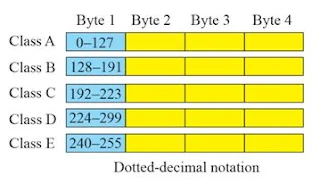
We will be discussing IPv4 addresses and their classes today. For all the doubts/clarifications regarding the topics we're covering as a part of PK Series (IT), you can always post them in comments section and I'll get back to you with answers.
What is an IPv4 address?
IPv4 address is a 32 bit address that uniquely defines the connection of a host to internet. Each byte, or 8 bit segment of the address, is divided by a period and typically expressed as a number 0-255. Each segment is referred to as an octet.
A typical IPv4 address looks like 192.168.0.2 (lowest value - 0, highest value- 255).
The address space of IPv4 is 2^32 (2 raise to power 32).
Classes of IPv4 addresses
IPv4 addresses are divided into 5 classes, named A through E, meant to differentiate segments of the available addressable IPv4 space. These are defined by first 4 bits of each address. Below, we find the description of classes.
Class A
The range of class A addresses is from 0.0.0.0 to 127.255.255.255. The first octet is used to identify the network and remaining three octets for identifying host (network.host.host.host).
This class is usually used for large networks. The address 127.0.0.1 is known as loopback address (localhost) and is used for testing network testing.
Class A addressing can have 126 networks (27-2) and (224-2) hosts as here 8 bits are for network and 24 bits are for hosts. we must also know that first IP of the network is network number and last IP is reserved for broadcast IP. Hence we have decreased 2 IP addresses above.
Class B
Class B includes addresses from 128.0.0.0 to 191.255.255.255. Here, first 16 bits are used to identify network and remaining 16 bits for identifying hosts (network.network.host.host)
This class is usually used for mid-size networks.
Class B has 214 network addresses and 216-2 host addresses.
Class C
Class C includes addresses from 192.0.0.0 to 223.255..255.255. This class is used for small to mid sized networks.
Class C has 221 network addresses and 28-2 host addresses.
Class D
Class D includes addresses from 224.0.0.0 to 239.255.255.255. These are known as multicast addresses. In multicasting, data is not destined for a particular host that is why no need to extract host address from the IP address.
Class E
This class includes addresses from 240.0.0.0 to 255.255.255.255. These addresses are reserved for future and experimental use and are largely not used.

NetID and HostID representation of classes
The figure below will give you a fair amount of idea about what we discussed about octets reserved for networks and hosts in each class.

Fun Internet fact of the day
The best connected cities are in South Korea and Japan.
(Shinzo Abe is in India currently, time to get some serious inputs!)
Happy Studying.
Deepak A.


